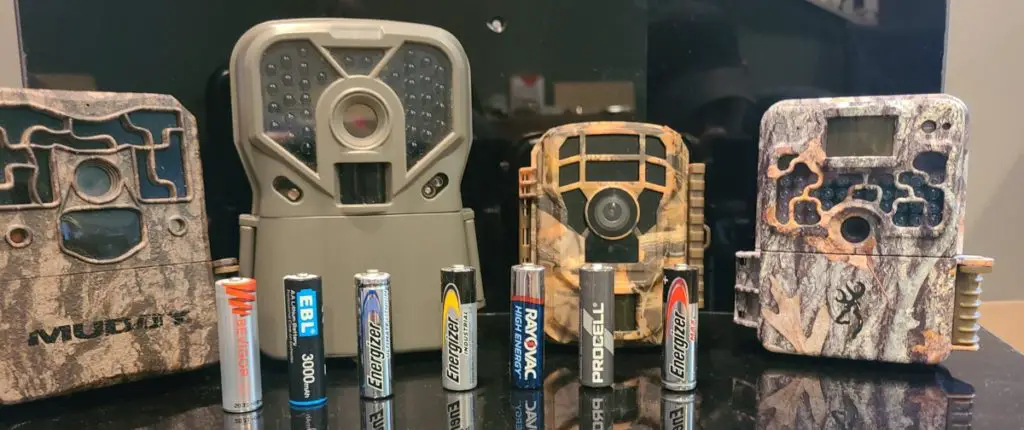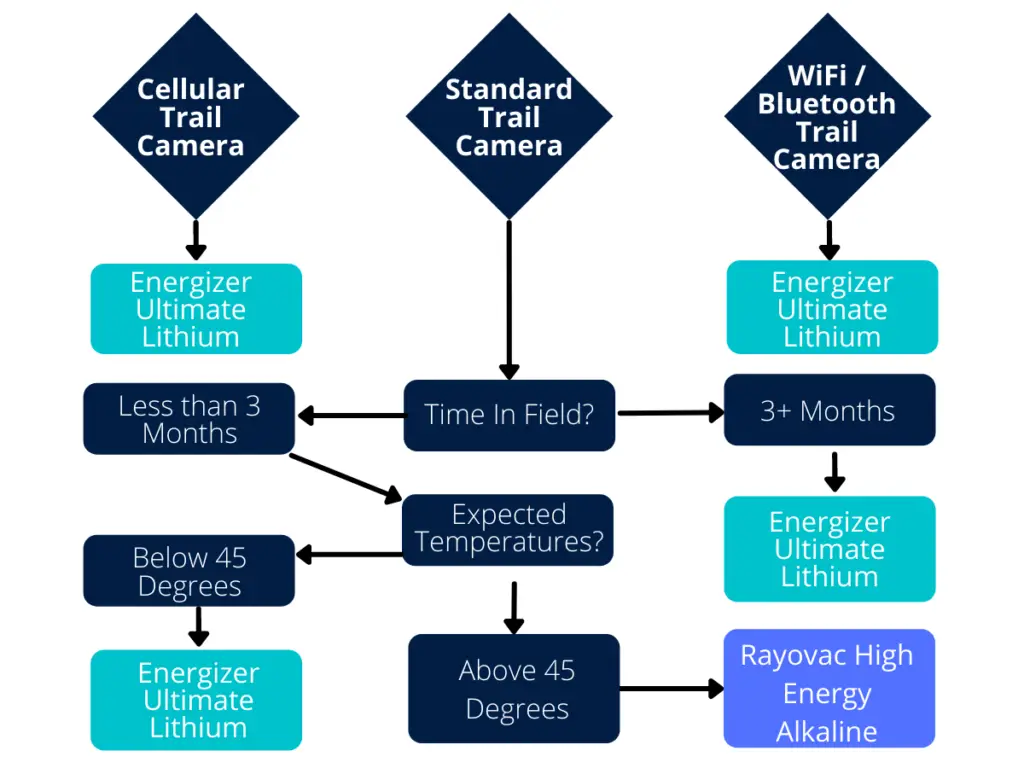After picking out the best trail camera for your situation you are faced with more decisions on SD cards, and batteries. While you can find what you need for a SD card here, What about batteries? What is the most economical battery, which battery will provide more photos, and how about durability in cold weather?
I have spent months doing nothing but testing batteries in trail cameras in an attempt to find the answer to this seemingly very basic question. The very expensive and tedious task of running literally thousands of batteries through trail cameras, resulted in a relatively straight forward answer.
Energizer Ultimate Lithium ion is the best battery for trail cameras. It outperformed all batteries in photos taken, durability in cold weather, and best performance in trail cameras. The Rayovac High Energy Alkaline, however, provided the best economical value.
In order to have a more accurate depiction of battery consumption, I used four different trail cameras: Exodus Trek (8 batteries), Muddy Procam 20 (6 batteries), Campark t20 Mini (4 batteries), and the Browning Strike Force Extreme (6 batteries).
For each of the battery make and model, I set all four cameras on timelapse mode, and let them take as many pictures as possible. Then I recorded the amount of photos taken, and averaged them out to get an accurate usage among all four cameras.
With every battery tested, I did this test twice. The first time the camera’s were placed in my office, where the temperature normally fluctuates between 67-69o. The second test took place in my refrigerator, that is set at 37o. This gave me an accurate depiction of the batteries consumption rate in both normal and colder temperatures.
The following was my findings from the months of experimenting with all of these batteries.

Battery Options
Alkaline
Pros
- Price- Of all the batteries, the price of alkaline, is the cheapest per battery. At around $0.60 per AA battery, the upfront cost of Alkaline batteries is very inexpensive.
- Available – It is easy to find alkaline batteries. Especially during post COVID 19 pandemic, where some batteries like lithium are very difficult to come by, alkaline batteries are still widely available.
Cons
- Cold weather- Alkaline batteries contain a water based electrolyte. As weather begins to freeze, the chemical reaction within the battery begins to slow down, reducing overall performance.
- Life Span– In many applications Alkaline batteries are very effective. In trail cameras, where the drain rate is much higher, the life span is dramatically decreased.
- Performance- Alkaline batteries are much more suited for slow current usage rates, such as a TV remote or an alarm clock. Alkaline batteries begin their life cycle with 1.5 volts of energy. As power is used they slowly discharge their power, until they hit a cutoff point of .8 volts. Most trail cameras require 12 volt systems to work properly (8AA). As the Alkaline battery slowly discharges and losses its voltage, it no longer has the appropriate amount of voltage to supply the camera to work at its highest level. You will often see things such as the flash mode, or the PIR detection circuit begin to fade as more battery is being used.
In the beginning of my testing process I was a little overwhelmed with the amount of Alkaline batteries to choose from. Every battery manufacturer has a AA alkaline battery on the market, and most have more than one option. So I tested as many as I could think of from Duracell, Energizer and AC Delco, to Rayovac, Kodiak, and even Amazon brand.
While I tested many different brands and models, I decided to only include 4 of the top performing batteries in order to avoid long tables of repetitive numbers.
| Battery | Indoor Temp (68o) | Refrigerator Temp (37o) |
|---|---|---|
| Energizer Max | 18,232 average photos | 11,153 average photos |
| Duracell ProCell | 15,259 average photos | 12,224 average photos |
| Energizer Industrial | 14,725 average photos | 10,539 average photos |
| Rayovac High Energy | 16,026 average photos | 11,582 average photos |
Lithium
Pros
- Life Span- On average, Lithium batteries last 42% longer than alkaline batteries
- Cold Weather Performance- Lithium batteries due to their composition do not have a water based electrolyte like Alkaline batteries do. Therefore freezing weather conditions do not have the same affect. These batteries are rated for up to -40 F.
- Consistent Output- Lithium batteries run ‘hot’ meaning they are charged with more than 1.5 volts (closer to 1.7 volts). Since the do not have the same chemical makeup of water based electrolytes the discharge is handled differently within the battery, allowing them to produce at least 1.5 volts for its entire life cycle. This means that there will be a consistent 12 volt power source to operate all the needed functions of the camera at its highest levels.
Cons
- Cost- The upfront cost of Lithium batteries is about twice the amount of alkaline batteries. At roughly $1.63 per battery, using this option will cost you around $13.06 (12 volt, 8AA ) to run one camera on Lithium Batteries
- No Indication of low battery- Due to the consistent output of voltage, Lithium batteries will always read at least 1.5 volts, until they die. Thus, your camera will nearly always read 100% battery. This can make things frustrating when trying to keep fresh batteries in cameras. You could check your camera one day, and have it read full battery, and no more than 2 days later they could be completely dead.
| Battery | Indoor Temp (68o) | Refrigerator Temp (37o) |
|---|---|---|
| Energizer Ultimate Lithium Ion | 28,331 average photos | 30,674 average photos |
| EBL Lithium | 25,074 average photos | 26,205 average photos |
| Bevigor Lithium | 22,229 average photos | 22,423 average photos |
NiMH Batteries
Pros
- Cold Weather Performance- Much like Lithium batteries, the performance during cold weather is comparable to the performance in warmer temperatures
- Long term cost savings– While the up front cost of rechargeable batteries might scare some people off, the savings over long periods of time, is well worth the investment.
- Eco friendly– Unlike Alkaline and Lithium batteries, these batteries are recharged, meaning less waste of you would normally get with one use and toss.
Cons
- High discharge rate – Similar to Alkaline batteries, once these batteries enter the camera, they begin to immediately discharge power.
- Recharging– If you have ever ran NiMH batteries you know the pain it can be to constantly having to recharge batteries. You always have to have a pile of charged batteries and dead batteries, and it becomes a legit pain.
- Up front cost– The upfront costs of rechargeable batteries is a investment. Not only are the batteries themselves more expensive, but you have to buy a charger as well.
What Battery Lasts the Longest In a Trail Camera?
When it comes to which battery lasts the longest in a trail camera, the race was not even close. Lithium Batteries easily outperformed Alkaline batteries in both optimal temperatures and cold temperatures. The best of the lithium batteries was the Energizer Ultimate.
Indoor Temperature (68o)
| Battery | Average Photos Taken |
|---|---|
| Energizer Ultimate Lithium ion | 28,331 Photos |
| EBL Lithium | 25,074 Photos |
| Bevigor Lithium | 22,229 Photos |
| Energizer Max Alkaline | 18,232 Photos |
| Rayovac High Energy Alkaline | 16,026 Photos |
| Duracell ProCell | 15,259 Photos |
| Energizer Industrial Alkaline | 14,725 Photos |
Refrigerator Temperature (37o)
| Battery | Average Photos Taken |
|---|---|
| Energizer Ultimate Lithium ion | 30,674 |
| EBL Lithium | 26,205 |
| Bevigor Lithium | 22,423 |
| Duracell ProCell Alkaline | 12,224 |
| Rayovac High Energy Alkaline | 11,582 |
| Energizer Max Alkaline | 11,153 |
| Energizer Industrial Alkaline | 10,539 |
What Battery is the Most Economical for Trail Cameras?
Warm Weather (68o)
When used during warm temperatures, economically there are two batteries that stand out among the rest: Rayovac High Energy Alkaline and Duracell Procell Alkaline. Both have fairly low cost per battery with decent photo averages.
| Battery | Average Photos Taken | Price Per Battery | Photos per $1* |
|---|---|---|---|
| Rayovac High Energy Alkaline | 16,026 | $.33 | 8,094 |
| Duracell Procell Alkaline | 15,259 | $.32 | 7,947 |
| Energizer Industrial Alkaline | 14,725 | $.39 | 6,293 |
| Energizer Max Alkaline | 18,232 | $.58 | 5,239 |
| Energizer Ultimate Lithium | 28,331 | $1.71 | 2,761 |
| EBL Lithium | 25,074 | $1.69 | 2,478 |
| Bevigor Lithium | 22,229 | $1.50 | 2,470 |
Cold Weather (37o)
When it comes to cold weather, looking at the numbers it seems as though the Alkaline batteries are still the best option economically. While it might be true, there are many other factors to consider, such as the discharge rate, and the overall performance. When the weather gets cold, it is most important to think about taking care of the trail camera, and providing it the power it needs to perform through the cold temperatures.
This is why despite the economic value of the alkaline cameras, I recommend using Energizer Ultimate Lithium during the colder months of the year, provided you live in an area where the temperature dips below freezing.
| Battery | Average Photos Taken | Price Per Battery | Photos per $1* |
|---|---|---|---|
| Duracell Procell Alkaline | 12,224 | $.32 | 6,367 |
| Rayovac High Energy Alkaline | 11,582 | $.33 | 5,849 |
| Energizer Industrial Alkaline | 10,539 | $.39 | 4,504 |
| Energizer Max Alkaline | 11,153 | $.58 | 3,205 |
| Energizer Ultimate Lithium | 30,674 | $1.71 | 2,990 |
| EBL Lithium | 26,205 | $1.69 | 2,589 |
| Bevigor Lithium | 22,423 | $1.50 | 2,491 |
Which Battery is Best For Your Trail Camera?
Now that we have went through all of the findings of this battery consumption study, the ultimate question remains: What battery should you use in your trail camera?
The answer to that question might not be so cut and dry. There are tons of different scenarios such as weather, length of time in the field, and the type of camera you are using, all of which might change your choice of battery.
In order to make this decision a bit easier I broke down the questions I ponder before selecting a battery for my trail camera, giving you a better idea of how to balance performance and economics of your choice.

I personally run all of my trail cameras on a holiday basis. I try to get all of my cameras in the field by Memorial day ( Last Monday of May). I make my first check of trail cameras on 4th of July (July 4th), and my second and final check on Labor Day ( First Monday in September).
With these holidays, also meaning more time from work, I am able to keep track of how often I check on cameras, and keeps me from staying out of areas too much.
To give you a brief understanding of how you can plan your trail camera battery strategies, Here is a quick breakdown of my trail camera strategies and how I choose batteries.
- Memorial Day – The temperatures are increasing, and there is little to no chance of temperatures dropping below freezing. I plan on checking cameras by July 4th, so I don’t worry about long term soaking of cameras. Battery of choice : Rayovac High Energy
- 4th of July- The temperatures are typically very warm, and there is an expectation that I will be checking cameras again in early September. Battery of Choice: Rayovac High Energy
- Labor Day- Labor day is the last time I schedule a check on all my trail cameras until the end of the year. This means there will likely be very cold temperatures in December, and I will be leaving the cameras out for at least 4 months. Battery of Choice: Energizer Ultimate Lithium
- New Years Day- For most of my trail cameras I begin to take them out of the woods around New Years Day. For the ones that I move into winter locations, they will undoubtedly face extremely cold temperatures. With various amounts of snow fall there is never a certain amount of time these cameras will stay in the field. Battery of Choice: Energizer Ultimate Lithium

